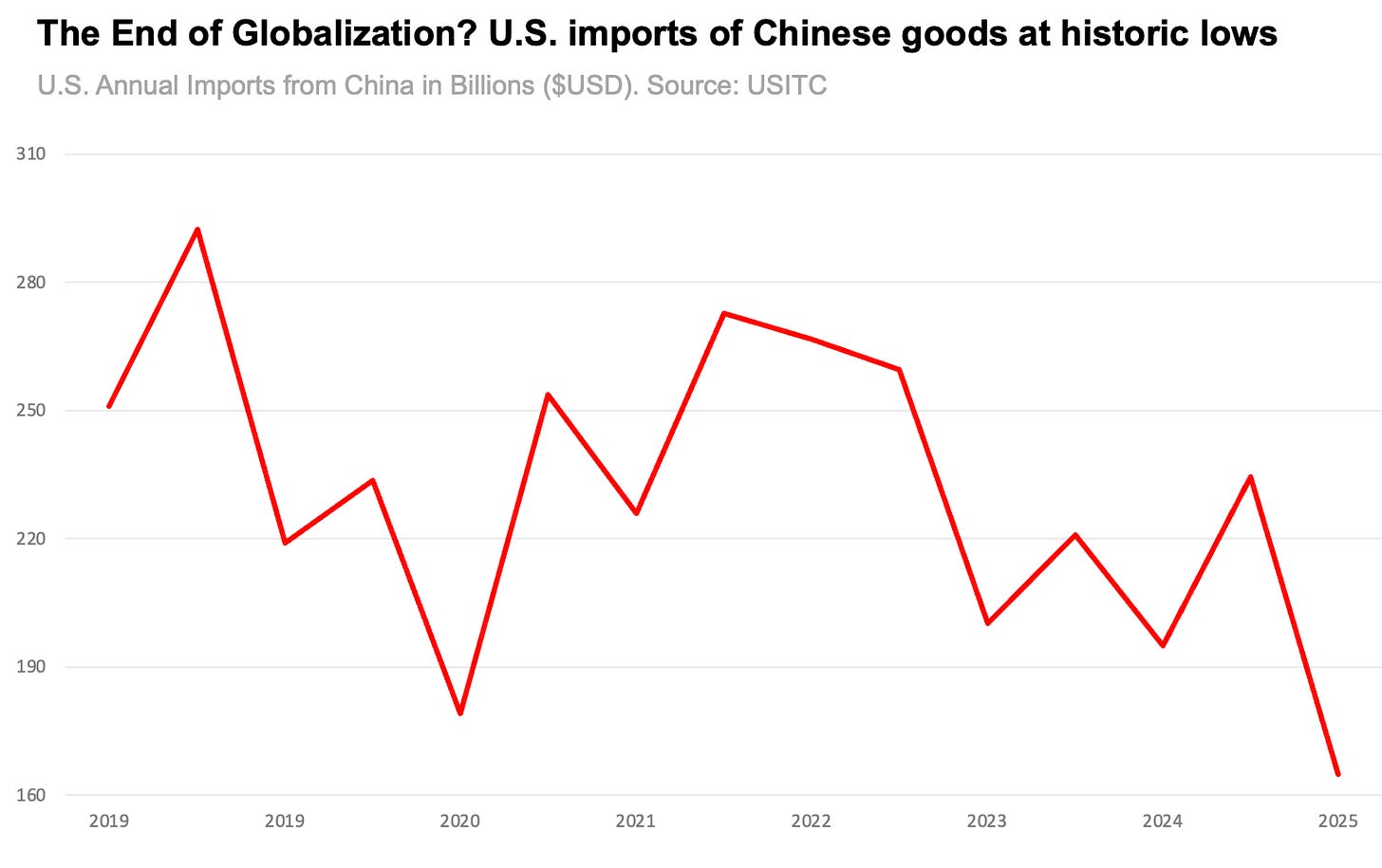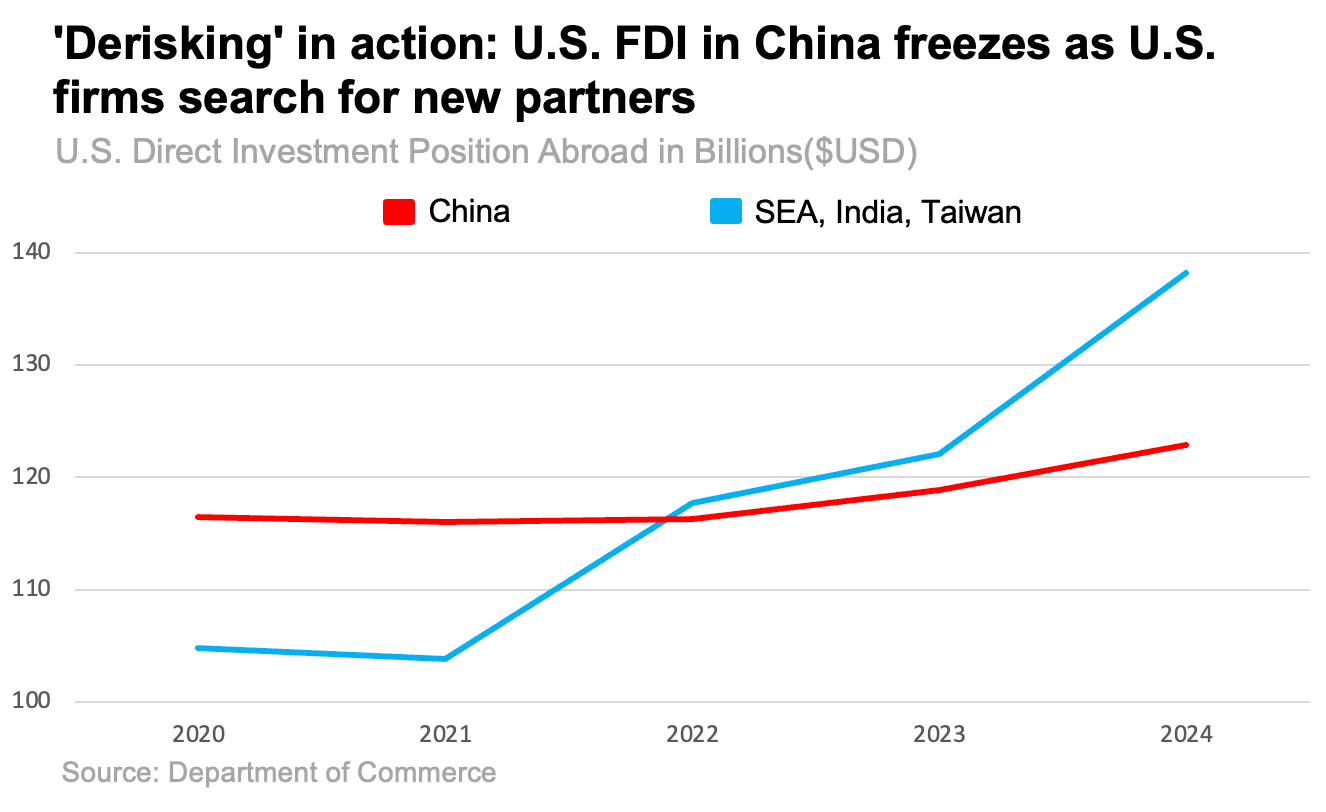ChinaCharts 1: The Tariff War Illusion
Foreign direct investment (FDI), not trade, shows the real U.S. - China split
A worker in a pharmaceutical plant in China, one of the only sectors in China experiencing a rise rather than fall in foreign investment. Source: fdiIntelligence
For the last five months, few news stories have dominated the headlines like Trump's trade war. Awkward White House audiences with foreign dignitaries, surprise tariff announcements, and European leaders lining up to kiss the ring have become a news staple in the new American Twilight Zone. The latest twist from Judge Rudolph Contreras has proven no less dramatic.
China fits uncomfortably in this new media reality. It's unique place as America's greatest rival and deepest dependency gives it many faces it schizophrenically cycles through in the American imagination. At times, it's a rising rival that must be contained. At others, a patient and shrewd operator waiting to pick up the pieces of the Liberal International Order (or, whatever's left after Palestine anyways). And, sometimes, an abusive partner and dependency with no clear exit.
The U.S. and China's rapidly souring trade relationship is, supposedly, meant to show the beginning of a 'Great Divorce'; a tectonic, globally-transformative event where the world's two largest economies mutually split ways and on-shore their respective economic dependencies. China starts manufacturing chips, medical instruments, and other advanced technology. America starts producing in Trump's grand vision, hopefully, toys. And, lending credence to this, is the apocalyptic fall in Chinese direct exports to the U.S. in the last few months.
This picture, however common in the financial press, is inaccurate in two ways. The first is that, if looking at U.S. imports of goods with substantial Chinese contribution rather than strictly goods marked as “Made in China”, it’s unclear if the 'Great Divorce' is actually happening. U.S. - Chinese mutual trade dependency has, if anything, only demonstrated its utmost resilience. The second is that Trump's April tariff war is only one part of a much greater and more comprehensive bipartisan decoupling drive dating back to 2018, which encompasses aspects of the U.S. - China relationship beyond just trade. As China's steadily climbing post-Liberation Day export numbers have shocked the commentariat, it only takes one quick look at foreign investment flows into China to see where the change is really happening.
In short, if you want to see where the 'Great Divorce' is happening, you need to look exactly where the press is not.
The Paradox of Trade
The broad consensus for the current moment is deceptively simple. High, punitive tariffs have made Chinese imports uncompetitive, and so we're going to struggle through inflation and empty shelves for a while until we can find someone else to buy everything from. Just take a look at the graph of U.S. imports of Chinese goods I put earlier, see the big line going down after April, and shrug. Seems right to me!
Before going in the direction many readers are expecting this section to take and discuss Chinese goods routed via intermediary states, a much more basic reframing needs to be made. Right now, ask yourself: do you think any country that is America's fourth biggest source of imports is just a small, unimportant trade partner? No?
Well, that's Vietnam. As of June 2025, China is still the U.S.' third largest source of imports behind Canada and Mexico.
In June alone, America still imported $18.9 billion in goods directly from China. Even months into the trade war, the U.S. is likely to import over $200 billion in goods from China by year end. Forgetting transshipment or shifted supply chains through intermediary states like Vietnam for a second, the U.S. and China still trade bilaterally in the hundreds of billions of dollars a year.
But, for this trade-centric decoupling narrative to fall apart further, one only has to look at Southeast Asia. As noted by the better parts of the financial press, Chinese exports to Southeast Asian states, and their respective exports to the U.S., have exploded. While these supply chains date back to the first trade war in 2018, China's exports to Southeast Asia since April have grown almost lock-step with the decline of U.S. - China bilateral trade. As I outlined in earlier reporting, much of this can be attributed to gray market transshipment as well.
I didn't say Vietnam was the U.S.' fourth largest source of imports for nothing, earlier, did I? Whether China-centric supply chains, where Chinese firms capture most of the value-chain before exporting the products to be finished in Southeast Asia, or pure illegal transshipment - 'Made in China' doesn't mean anything. Wherever it's 'Made', the mutually dependent, deeply interconnected U.S. - China relationship remains.
But, many relationships that end in divorce still have their good parts. There's just one, or more, absolutely intolerable parts that bring things to their end. For that, we just have to look at a different kind of international flow: foreign direct investment.
A Stalled Decoupling
While the U.S. - Chinese trade relationship has been defined by a surprising resilience, the fall in foreign direct investment (FDI) into China in 2023-2025 cannot be described as anything but epochal. From all sources and on all fronts.
A notable difference from trade, and why it's important to consider the U.S. - China relationship beyond Trump, is that the collapse in Chinese inward FDI predates Trump's inauguration by two years. What we're looking at is not just a five month tariff slapfight, but the latest development in a multi-front, multi-year economic war. 'Liberation Day' tariffs are unique not because of their willingness to try and sever American dependence on China, which is a characteristic they share with many older Trump or Biden era policies, but because of their severity and aggressiveness. The Second Tariff War is a difficult beast to grasp because it shares many continuities with the last 7 years of bipartisan China policy while being fundamentally different in just as many ways. As I reported before, Biden tried to give coherence and strategy to the similarly erratic tariff war he inherited from the first Trump term, to decidedly mixed and dissapointing results.
Trump has, once again, decided to act first and ask questions later.
It's true that the fall in inward FDI from all nations into China cannot solely by attributed to the vicissitudes of U.S. - China relations. Tariff barriers have risen all across the globe in response to China's climbing exports and China's high-tech indigenization effort has pushed global multinationals out of many domestic markets. But, the potentially catastrophic consequences of Chimerica's latest drama is clearly setting the pace for global multinationals, and they are listening. A look at trends in American FDI in Asia over the past couple years at least sheds light on the behavior of American multinationals: U.S FDI into China is frozen, while investments into the rest of Asia are not.
Teasing out the distinctions between the tariff war, the greater decoupling drive, China's increasing frostiness to foreign firms, and their - in my opinion - fundamental interrelation, is a topic that requires its own article that I will write sometime soon. But for now, what I will say is that these are not issues that should be considered separately. U.S. decoupling and China's push for high-tech autarky are two parts in a rapidly spiraling negative feedback loop, where each escalation in the weaponization of America's dominance in high-tech sectors via export or investment restrictions leads to an intensification of China's determination to end its dependencies on the U.S.
On the bright side for China's surely exhausted trade negotiators, it seems Trump has put down China and moved on to shinier toys. Newly announced 50% tariffs on India and punitive tariffs on many Southeast Asian states for permitting Chinese transshipment has now made China, strangely enough, a cheaper place to export from than many of America's friends. Like everything else in the Trump regime, how long this calm will last is anyone’s guess.
(Since drafting that paragraph one week ago, it’s come out that Trump has just pushed the EU to impose 100% tariffs on China and India. Hopefully, the negotiators enjoyed their break)
This is the first of a new series focusing on all things China through the lens of charts, data, and my ramblings. Subscribe for more ChinaCharts!






